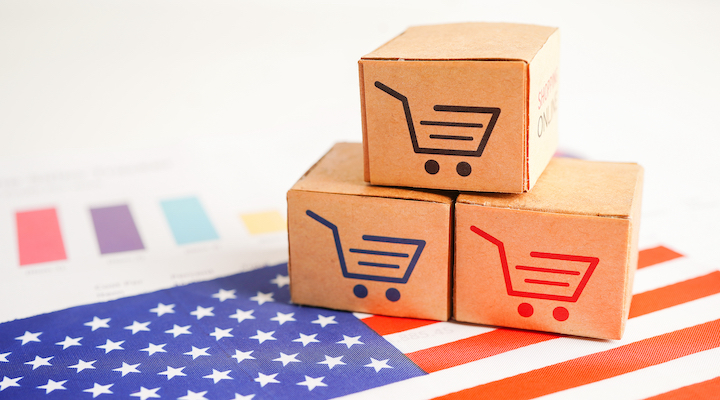Selling online in the US can be lucrative, as many Australian retailers and brands are discovering. But there is a fine line between success and failure.
Tara Daly, senior director of product marketing at Loop Returns, shares with Inside Retail advice on getting started in the US market, some tips on cross-border shipping and logistics – including managing returns in a way that builds customer loyalty – and how to drive repeat business.
Loop is the leading post-purchase platform optimising returns, post-purchase, and reverse logistics for more than 3500 brands, representing about 15 per cent of Shopify’s gross merchandise value. The Shopify-backed company has more than 250 employees and oversees 2 million returns per month.
Baby steps
Daly says retailers eyeing the US market should not try to create a “one size fits all experience”.
Begin with baby steps, she advocates. “Don’t outsource your inventory and localise your entire website on day one. Start by researching the landscape and your competitors. Localise your home page and checkout experience and invest in some marketing so you can start to assess demand.
“Making the whole international shopping experience seamless is a journey that takes time, so don’t expect everything to be perfect right away,” she continues.
“You need to really lean into understanding your customer and their value and create personalised experiences that minimise wasteful spending for you as a retailer and that also drive customer retention.”
Daly advocates creating a loyalty program to reward top customers and keep them coming back and progressively localising your website and marketing engagement strategy to connect with the local target audience.
“Don’t fall into the trap of assuming they think and act the same, so use a mixture of email, SMS, social media, and other channels to communicate with them.”
Cross-border shipping and the ease of returns
Australian retailers targeting the US market need to bear in mind that delivering a smooth returns experience for customers is key to securing repeat business from them.
The shipping and returns processes offer retailers a real opportunity to elevate the customer experience, says Daly, who advises retailers to think strategically in customising the experience for different clients which helps maximise the return on investment.
A clear and seamless returns experience is critical. Even better, she says, look at ways to integrate another shopping experience if customers want to exchange goods, by offering incentives for additional orders.
“The ease of returns has become a basic expectation among consumers shopping online. Consumers expect a seamless, self-serve experience that offers transparency through the journey, for example, such as track and trace can offer.”
Daly recommends customising returns to offer high-value customers a VIP experience. For example, fee-free exchanges or returns, and approving refunds based on scanning a label rather than requiring a physical inspection of the goods.
Data is key to understanding customers and tailoring your cross-border offering to optimise customer satisfaction and optimise return costs, she explains.
“Returns data can unlock valuable insights into the customer’s buying behaviour as well as your product market fit. Analysing returns data can help you identify costly product issues – such as a sizing issue with a top, for example – much faster than you can address by making your product listing clearer by altering product descriptions or images. That data might also help you identify a fit issue with the manufacturer.”
Five key steps to driving repeat purchases
Once you have a customer base and an efficient returns process locked down, what are the best ways to ensure those customers come back for more? Daly offers five key steps to help build loyalty among overseas customers…
Make sure you follow the correct duties and customs procedures: Customers hate getting hit with surprise fees when they receive their overseas orders. But they won’t be hit with fees if you as the cross-border retailer follow the correct processes for duties and customs. If you set up your store correctly on Shopify, this will all be managed correctly, says Daly.
Secure the best carrier rates: Retailers shipping abroad need to make sure they are securing the best carrier rates, a vital step when thinking about international shipping, says Daly. “When you do returns with Loop we lock the best rates in with local carriers to ensure you are spending the minimum on shipping, while still maximising service,” she says. Ship By Loop allows Loop customers to create carrier accounts directly within Loop, so they can easily get access to the best negotiated rates. Furthermore, Loop can use a consolidator to aggregate inventory for return to Australia or re-fulfilling orders within the US – driving down a retailer’s costs even further.
Choose carefully where you keep your inventory: When starting out, it is wise to keep your inventory where your business is based. This way you can understand consumer demand and the purchasing behaviour of overseas customers before you commit stock and logistics to third-party partners in the markets you are targeting. Once you understand the patterns of buying behaviour, then you can outsource to a local third-party logistics (3PL) partner.
Balance customer experience with recovering shipping costs: Daly advocates caution when calculating shipping fees so as not to impact the customer experience. One way to achieve this is to incentivise shoppers to purchase more – and thus increase their order value – by offering free shipping above a threshold.
Strategise returns with dynamic routing: Shipping returns back to your home base can be costly, so think strategically about where you are going to have returns shipped. “For example, if the item cannot be restocked, ship it to a local reseller or a donation centre and save on the return shipping costs,” suggests Daly. “This will also increase your sustainability commitment.”
About Loop Returns
Loop Returns helps retailers optimise their operations by saving time and money, enabling them to reinvest in their business, and increasing customer lifetime value by delivering the best returns experience and providing key retention tools. Loop also helps reduce loss to fraud by providing retailers with the tools they need to identify and reduce fraudulent returns.






